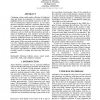Free Online Productivity Tools
i2Speak
i2Symbol
i2OCR
iTex2Img
iWeb2Print
iWeb2Shot
i2Type
iPdf2Split
iPdf2Merge
i2Bopomofo
i2Arabic
i2Style
i2Image
i2PDF
iLatex2Rtf
Sci2ools
ISMIR
2005
Springer
2005
Springer
Herding Folksongs
Cataloging a large, multi-media collection of traditional song and drama in preparation for online presentation highlights issues of song identity and access in the context of contemporary digitized archives. In the James Madison Carpenter collection a particular folksong sung by a particular individual may exist in multiple manifestations: typed song text, sound recording(s), and/or manuscript music notation. While controlled vocabulary references such as Child and Roud numbers provide a degree of identification, such narrative- and text-centric tools are only partly effective in differentiating folkloric materials. Additional means are needed for identifying and controlling folk materials which are distinguished by other aspects of the song such as melody or non-narrative text. The Carpenter project team’s experience with Encoded Archival Description (EAD) illustrates the value of this platform-independent, widely recognized standard and suggests opportunities for further developm...
Contemporary Digitized Archives | Information Retrieval | ISMIR 2005 | Madison Carpenter Collection | Song Identity |
| Added | 27 Jun 2010 |
| Updated | 27 Jun 2010 |
| Type | Conference |
| Year | 2005 |
| Where | ISMIR |
| Authors | Robert Young Walser |
Comments (0)

